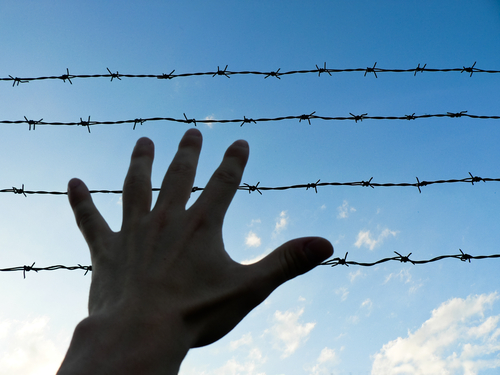On October 22, 2013 America lost a hero, General Robinson Risner, Word War II combatant, Korean War ace and Vietnam prisoner of war senior leader. The history books will note Risner’s two Air Force Crosses, his courage under torture, his outstanding aviation in three wars and his long commitment to the military. I will remember him for being nine feet tall.
I met General Risner for the first time in 1995 when he visited the Navy’s POW research center in Pensacola where I was completing my doctoral dissertation about leadership among the Vietnam prisoners of war. I had the privilege of serving as the general’s escort during his visit to the center and of hearing other POWs tell me stories about his courage and valor.
Two weeks prior to General Risner’s arrival, a former Air Force captain who had shared a cell with then-colonel Risner recounted a story that affected him personally. As the senior-ranking officer, Risner had decided to attempt a new communication technique, something that was likely to have consequences for the person caught engaging in it. The captain pointed out that he should be the one to attempt the mission, because – in the captain’s words – if the captors caught Risner, they “will beat the hell out of you, sir.” The captain’s right-minded thinking was that the captors would be less angered by a junior officer breaking protocol than by that troublesome senior-ranking officer doing so. Risner refused the young man’s offer, pointing out that he would never put a junior person in harm’s way to avoid peril himself.
The captors did catch Risner and did very nearly kill him. As the captain recalled the incident, he tearfully explained that “Robbie Risner saved my life, not just that day, but each day of my captivity.” Risner’s leadership and bravery acted as a guiding light and principle for the POWs who all felt adrift and afraid.
During their captivity, Risner rewrote the Code of Conduct that the military had established after the Korean War and advised the POWs to disregard what they had learned about disclosing information or signing propaganda statements. Instead, Risner instructed his fellow prisoners that they should resist interrogation, but not endure torture beyond the point where “you lose your capability to think or lose the permanent use of your limbs.” Risner, who probably received more torture than anyone else, knew of what he spoke. He also understood that like him, each man had a breaking point that he shouldn’t be ashamed of.
Treatment of the POWs improved somewhat after Ho Chi Minh’s death in 1969, with fewer uses of isolation and incidences of torture. However, the captors continued to restrict the POWs’ unifying behaviors and ceremonies. During a church service in 1971, the POWs started singing “The Star-Spangled Banner,” which the captors forbade. Risner ordered the POWs to continue singing, as the captors dragged their leader to solitary confinement once again. His action that day also once again galvanized the POWs, augmented their determination and ultimately contributed to their returning resilient and hardy.
I had the honor of attending the 25th anniversary of the POWs’ repatriation, which Ross Perot hosted in Dallas. Perot invited the POWs who had attended the church service in 1971 and General Risner to join the Dallas Symphony Orchestra to sing the song Risner had been denied those many years before. General Risner sang our national anthem with the other POWs and remarked afterward that he once again felt the way he had in 1971—nine feet tall.
In reality, General Risner stood only five and a half feet tall. But as he explained during our interview, his father had told him he could be or do anything he wanted, but because he was little, he’d have to want it “more than the other fella and work harder to get it.”
Among Risner’s many other accolades, we should remember his role in protecting our POWs, who returned in 1973 with almost no incidence of Post Traumatic Stress Disorder. The 25-year follow-up study confirmed that only about six to eight percent of the POWs had received a PTSD diagnosis, a truly significant number when compared to other captivity situations and our current statistics among combat crews in the Middle East. I join others in crediting then-colonel Risner and those of his ilk for their extraordinary leadership during adversity. Their legacy of resilience lives on, even as each year brings to an end another life of one who served during that war.
Ross Perot commissioned a statue of Robinson Risner that today stands at the Air Force Academy. The statue is “life size,” meaning it’s nine feet tall.



 Dr. Linda Henman is one of those rare experts who can say she’s a coach, consultant, speaker, and author. For more than 30 years, she has worked with Fortune 500 Companies and small businesses that want to think strategically, grow dramatically, promote intelligently, and compete successfully today and tomorrow. Some of her clients include Emerson Electric, Boeing, Avon and Tyson Foods. She was one of eight experts who worked directly with John Tyson after his company’s acquisition of International Beef Products, one of the most successful acquisitions of the twentieth century.
Linda holds a Ph.D. in organizational systems and two Master of Arts degrees in both interpersonal communication and organization development and a Bachelor of Science degree in communication. Whether coaching executives or members of the board, Linda offers clients coaching and consulting solutions that are pragmatic in their approach and sound in their foundation—all designed to create exceptional organizations.
She is the author of Landing in the Executive Chair: How to Excel in the Hot Seat, The Magnetic Boss: How to Become the Leader No One Wants to Leave, and contributing editor and author to Small Group Communication, among other works.
Dr. Henman can be reached at
Dr. Linda Henman is one of those rare experts who can say she’s a coach, consultant, speaker, and author. For more than 30 years, she has worked with Fortune 500 Companies and small businesses that want to think strategically, grow dramatically, promote intelligently, and compete successfully today and tomorrow. Some of her clients include Emerson Electric, Boeing, Avon and Tyson Foods. She was one of eight experts who worked directly with John Tyson after his company’s acquisition of International Beef Products, one of the most successful acquisitions of the twentieth century.
Linda holds a Ph.D. in organizational systems and two Master of Arts degrees in both interpersonal communication and organization development and a Bachelor of Science degree in communication. Whether coaching executives or members of the board, Linda offers clients coaching and consulting solutions that are pragmatic in their approach and sound in their foundation—all designed to create exceptional organizations.
She is the author of Landing in the Executive Chair: How to Excel in the Hot Seat, The Magnetic Boss: How to Become the Leader No One Wants to Leave, and contributing editor and author to Small Group Communication, among other works.
Dr. Henman can be reached at 










